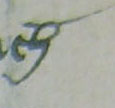|
| A |
 | Usage: came
a hairline joins the two sides of the square single compartment of 'a'. |  | Usage: hath
sometimes the lobe resembles a cup and the hairline join is not visible, if it was ever there. |
 | Usage: And |  | Usage: And
a quirky extension at the head of the upper lobe. |
|
| D |
 | Usage: worlde
a looped 'd' is more usually (though not exclusively) found in initial positions. |  | Usage: and
unlooped 'd' is generally found in final position in a word. |
 | Usage: dissobeye
the lower lobe of 'd' may be pointed, as here. This type of 'd' is the model for the upper case graph. |  | Usage: goodnesse
the length of the stem of 'd' is very variable. |
|
| G |
 | Usage: MUsing
the tail of 'g' is sometimes turned anti-clockwise. |  | Usage: right
the tail of 'g' is usually short when there is no reverse flick. |
 | Usage: goost
at the beginning of a word, the tail of 'g' is extended. The lobe of 'g' here is triangular and the head is flat. |  | Usage: might
the 'ght' combination. |
|
| H |
 | Usage: thing
'h' is generally squat with short limb with tiny tail which ends beneath the graph itself. |  | Usage: how
occasionally the tail-stroke turns anti-clockwise and retraces the line of the descent from the limb. |
 | Usage: grevith
crossed 'h' follows 't' in this combination. Not all 'h's are crossed. |  | Usage: Had
upper case letter at the beginning of a line. The shape is essentially the same as the lower case letter. |
|
| R |
 | Usage: resteles
'z'-shaped 'r' is by far the most frequently used graph for 'r'. It is used in all positions in a word, including final position. Here, in initial position, it does not sport the spike at the head as in version 2 where it follows another graph. |  | Usage: vnderstande |
 | Usage: hir
modern 'r' is used occasionally, mainly in final position. Here it sports a flourish. |  | Usage: Resceyue
upper case letter for this word in the middle of a line. |
|
| S |
 | Usage: resteles
this 's' is always used in final position. |  | Usage: strook
long 's' used in initial and medial positions. The stem is thick, the head-stroke finer and variable in length. When followed by 't' the 's' appears to lean against it. |
 | Usage: goodnesse
where 'ss' occurs, the first graph is usually shorter than the second. |  | Usage: So
upper case letter at the beginning of a line. |
|
| W |
 | Usage: wight
the most usual formation of 'w'. When in initial position, the approach stroke begins below the graph and curves up to the head of the initial stroke. |  | Usage: how
'w' in final position with no approach stroke. |
 | Usage: sawe
occasionally 'w' is formed in this way. Sometimes the tops of the left and middle limb are curled over. |  | Usage: Whan
the upper case graph is a larger version of 1. |
|
| Y |
 | Usage: troubly
'y' is generally formed in the same way. |  | Usage: yn
the tail of 'y' may be longer or shorter depending on space available. |
 | Usage: my |  | Usage: Yf
upper case 'Y' at the beginning of a line and on the last line of the folio. Hence the very long tail extending into the lower margin. |
|
| Thorn |
 | Usage: þis
thorn is used in all the usual ways and also to replace 'th' on occasion. |  | Usage: þought |
 | Usage: þt |  | Usage: þ(er) |
|
| Upper Case Letters |
 | Usage: Besily
difficult to entangle the elaborate shape of 'B' from this image. The head-stroke of the upper case 'T' on the second line crosses the descender of 'B'. The lead-in stroke to the 'z'-shaped addition to the front of 'B' describes an almost perfect circle beneath the graph. |  | Usage: Into
upper case 'I' with scooped approach stroke. |
 | Usage: The |  | Usage: What |
|
| Abbreviative Marks |
 | Usage: witt(es)
es' abbreviation. |  | Usage: savio(ur)
'ur' abbreviation. |
 | Usage: þ(er)
'er' abbreviation. |  | Usage: aqueynted
'd' with tag. |














































